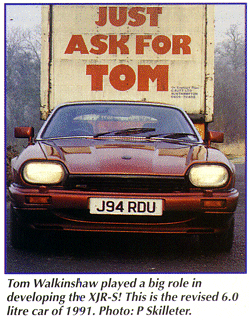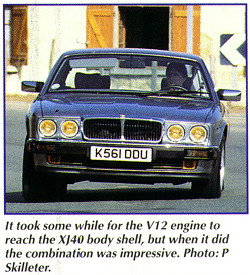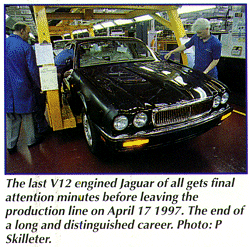|
|
 |
[ Main ] [ 1 ] [ 2 ]
[ 3 ] [ 4 ] [ 5 ] [ 6 ] [ 7 ] [ 8 ] [ 9 ] [ 10 ] [ 11 ] |
Electronic fuel injection evolvesBosch D Jetronic, whilst a very important ancestor of all modern EFI systems, was in fact rather primitive, having a multiplicity of transistors and other components using obsolete analogue techniques based on voltages and simple timer circuits. The vaguely timed one-shot-per-cycle fuel delivery was not good enough for the forthcoming HE engine so something better was needed.The definitive 10:1 compression V12 launched in 1980 used the new Lucas P Digital EFI system employing a main integrated circuit chip, consisting of a large number of transistor elements configured in manufacture to generate a map of the fuel requirement spread over hundreds of data points according to engine speed and load. Temperature and other corrections were still applied by analogue means but the important advance was that feedback correction from oxygen (Lambda) sensors in the two exhaust streams was now possible with the injectors for each bank corrected independently. This meant that modern three-way catalysts could be used to advantage in emission sensitive markets. An unusual feature of the Lucas systems which remained right through into the 1990s even as the ECUs evolved, was the complex dual output circuit for the injectors grouped for each bank. Basic injector pulses passed via a resistor pack whilst a current sensing bypass circuit produced direct additional short pulses to maintain the required overall injector current. Firing the injectors of each bank alternately twice per cycle satisfied the more critical HE mixture requirements when it arrived a year later The Digital ECU type 6CU was superseded in 1986 by the pin compatible, microprocessor based 16CU type, from which in turn evolved the 26CU and 36CU with increasing levels of sophistication. These were succeeded in 1994 by PECUS (Programmable Electronic Control Units System) an advanced management system incorporating ignition control and of much greater capability than its predecessors to meet ever more demanding emission legislation. As an aside from all these mainstream production systems, during the 1990s Zytec, a respected manufacturer of racing engine management systems, provided quite a number of control units for low volume applications such as the XJR-S. |

|
| [ Main ] [ 1 ] [ 2 ] [ 3 ] [ 4 ] [ 5 ] [ 6 ] [ 7 ] [ 8 ] [ 9 ] [ 10 ] [ 11 ] |
Email aj6engineering@ntlworld.com, Tel/Fax:- 0044 (0)1625 573556 |

